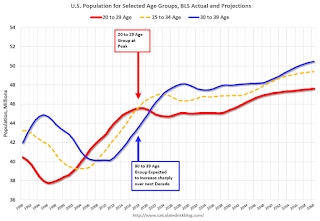by Calculated Risk on 3/01/2019 03:52:00 PM
Friday, March 01, 2019
Demographics: Renting vs. Owning
Note; This is an update to a post I wrote in 2015.
It was almost 9 years ago that we started discussing the turnaround for apartments. Then, in January 2011, I attended the NMHC Apartment Strategies Conference in Palm Springs, and the atmosphere was very positive.
The drivers in 2011 were 1) very low new supply for apartments, and 2) strong demand (both favorable demographics, and people moving from owning to renting).
The move "from owning to renting" is over, and demographics for apartments are much less favorable than 8 years ago. Also much more supply has come online. Slowing demand and more supply for apartments is why multi-family starts have slowed recently (multi-family starts probably peaked in 2015).
| Multi-family Starts by Year | |
|---|---|
| Year | 5+ Units (000s) |
| 2005 | 311.4 |
| 2006 | 292.8 |
| 2007 | 277.3 |
| 2008 | 266.0 |
| 2009 | 97.3 |
| 2010 | 104.3 |
| 2011 | 167.3 |
| 2012 | 233.9 |
| 2013 | 293.7 |
| 2014 | 341.7 |
| 2015 | 385.8 |
| 2016 | 380.8 |
| 2017 | 342.7 |
| 2018 | 359.7 |
On demographics, a large cohort had been moving into the 20 to 29 year old age group (a key age group for renters). Going forward, a large cohort is moving into the 30 to 39 age group (a key for ownership).
Note: Household formation would be a better measure than population, but reliable data for households is released with a long lag.
NOTE: This graph is updated using the Vintage 2017 estimates.
 Click on graph for larger image.
Click on graph for larger image.This graph shows the longer term trend for three key age groups: 20 to 29, 25 to 34, and 30 to 39 (the groups overlap).
This graph is from 1990 to 2060 (all data from BLS: current to 2060 is projected).
We can see the surge in the 20 to 29 age group (red). Once this group exceeded the peak in earlier periods, there was an increase in apartment construction. This age group peaked in 2018 / 2019 (until the 2030s), and the 25 to 34 age group (orange, dashed) will peak around 2023. This suggests demand for apartments will soften somewhat.
For buying, the 30 to 39 age group (blue) is important (note: see Demographics and Behavior for some reasons for changing behavior). The population in this age group is increasing, and will increase significantly over the next decade.
This demographics is now positive for home buying, and this is a key reason I expect single family housing starts to continue to increase.


